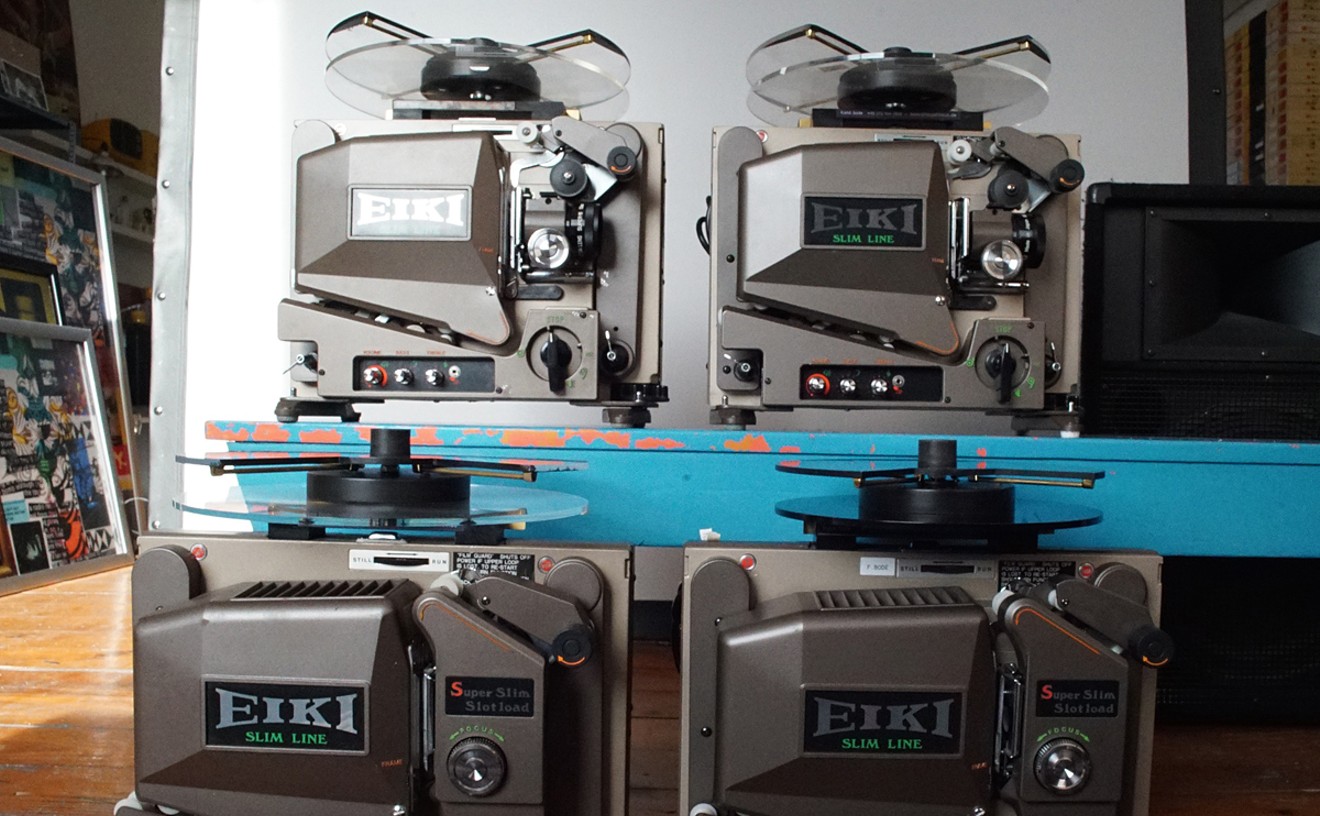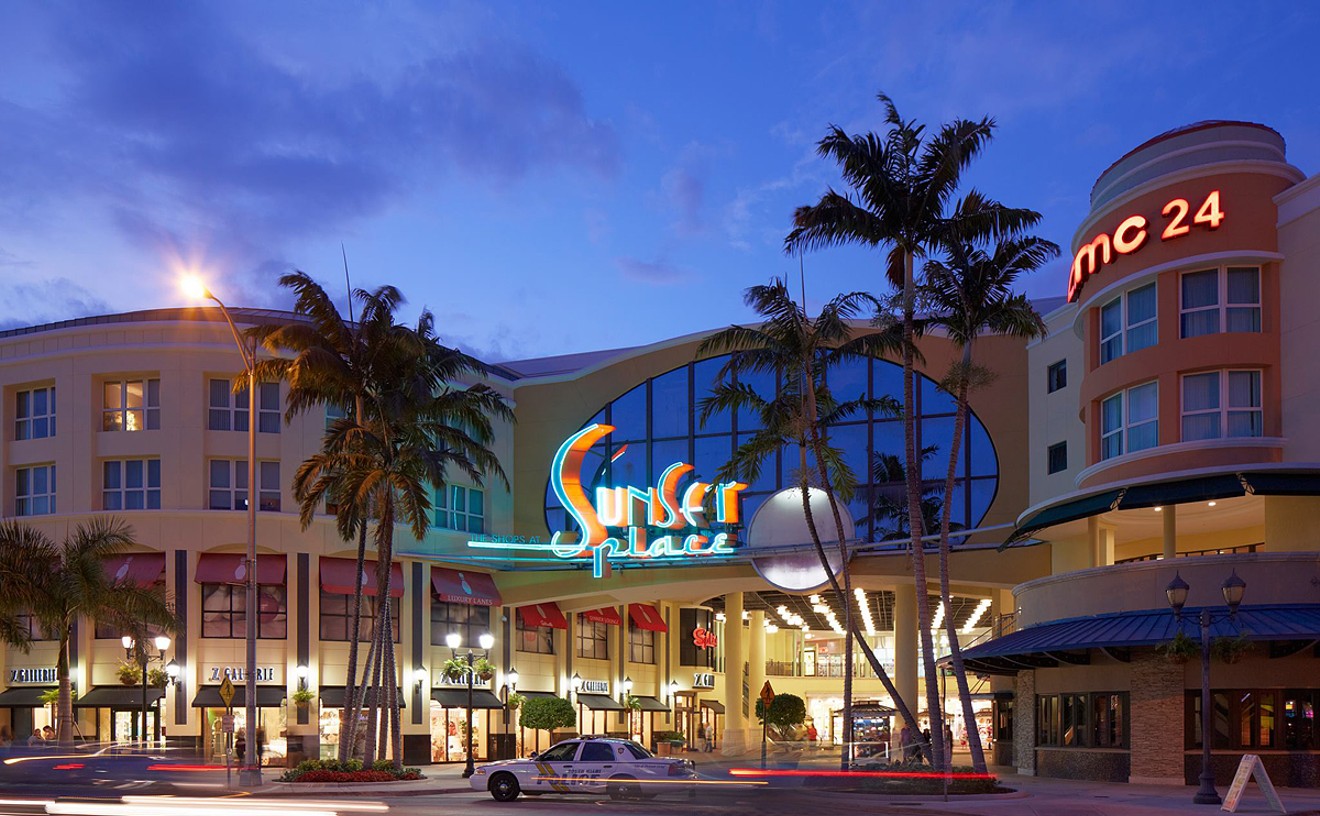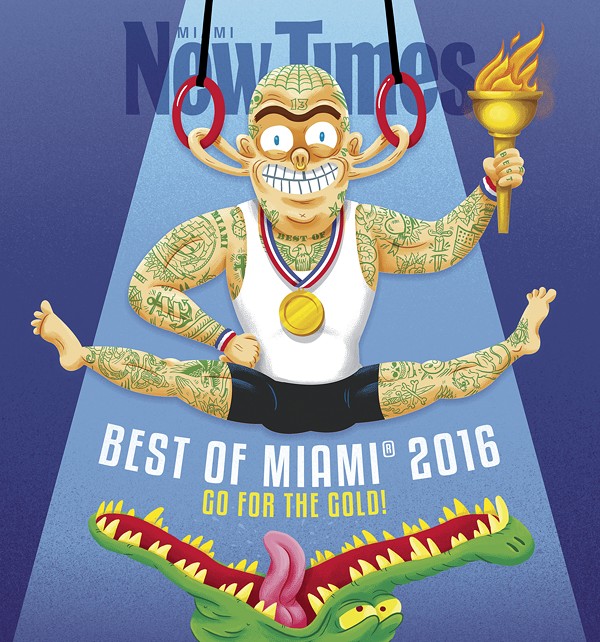After 13 years of sobriety, street artist Joaquin Lamar Hailey, better known as Chor Boogie, fell off the wagon about two years ago. So the San Diego-born artist, along with his wife, performance artist Elizabeth Bast, made a spiritual and medicinal journey to Gabon, Africa. There, they performed a ceremony involving the root iboga. After ingesting it, Hailey entered the spirit world. He destroyed his deeply rooted negativity, threw it in a trash can, and set it on fire. Love shot out of his third eye, cleansing him of the desire for toxins and inspiring him to create Hieros Gamos outside the Macaya Gallery. The painting depicts angry faces and stern eyes blossoming into something of a lovebird. Instead of depicting crinkled eyebrows, Boogie spray-painted love-soaked eyes and a heart beaming from a third eye. It is a testament to his rebirth.
Best Mural
Chor Boogie's Hieros Gamos
- 145 NW 36th St., Miami, 33023 Map
- 786-577-0322
- macayagallery.com
Best Street Artist
Marcus Blake
Buildings painted in psychedelic patterns are everywhere in Little Haiti. It's an aesthetic philosophy that local artist Marcus Blake calls "tapenology." Blake was born in Jamaica but moved to Miami at a young age. Though he's never returned to his homeland, visions of lush green fields occasionally float back to him. Once in Miami, Blake began innocently drawing psychedelic swirls on his mother's walls. It was the most natural act for him. Today, his work can be seen along NW Second Avenue from 64th to 80th streets. Like the veins in our palms or the vines of a tree, tape marks Blake's path along Little Haiti's streets. "That's my mentality: Go become a vine. Plant a seed and then ride it — don't map it out; just feel it," says Blake, whose work is divinely symmetrical. "These processes are the way of knowing myself. It's a meditation."
Best Wynwood Tour
Miami's Best Graffiti Guide
What was once a rundown warehouse and residential district has transformed in a handful of years to the hottest neighborhood in the city. Tons of tours by bus, bike, car, and foot make their way through Wynwood's streets, but many offer scant insight into the colorful culture of art and commerce. If you really want to learn Wynwood's history and comprehend the vibrant murals, turn to the artists. Miami's Best Graffiti Guide runs a variety of daily tours led by two guys who dedicated their lives to Wynwood's art scene years before iconic developer Tony Goldman sparked the neighborhood renaissance. Ryan the Wheelbarrow of Wynwood Mural Tours began offering free bike tours every Sunday at 4 p.m. a few years ago. Local artist Pedro AMOS, who had been a graffiti artist for decades, soon started his own Wynwood tour. The two joined forces this past January, and they have more collective knowledge of this scene than the Greater Miami Convention and Visitors Bureau (with whom they work). In fact, they are the official tour guides of Wynwood Walls. Tours range in price from $20 to $100. The guides also offer paint demo events for large groups — the cost is about $1,000 for those who wish to try their hand at graffiti on practice walls. The "can control crash course" comes with snacks, beverages, and supplies.
Best Alternative Art Space
Obsolete Media Miami

Back in the day, A/V kids were considered nerdy. But in the age of the internet, there is almost nothing cooler than a plain old film camera and some slides from a 1982 trip to Acapulco. This is what makes OMM (Obsolete Media Miami) the best alternative art space in Miami right now. Is it gross and edgy? Not exactly. It's clean and subversive in a different way. The experimental project was founded in the Design District last year by artists Kevin Arrow and Barron Sherer. The two, who have been around town for a long while, have gathered a notable collection of 35mm slides, cassette tapes, reel film, and archival motion-picture materials, among other "obsolete" media. And some museums have sent stuff to add to the pair's inventory. OMM is also a resource for other creative people to dip into and get inspired through workshops, lectures, and performances. These guys have analog everything and equipment for days. This isn't about nostalgia alone. This is about art and preserving the past of both the Magic City and a time when the A/V club meant something.
- 5 NW 39th St., Miami, 33127 Map
- 786-539-4142
- omm305.org
Best Photographer
David Bulit
Beauty is everywhere, even in ruins. At least that's what David Bulit believes. And he captures that every time he hits the shutter of his camera. The author of Lost Miami: Stories and Secrets Behind Magic City Ruins and the mastermind behind the blogs Abandoned Florida and Autopsy of Architecture, Bulit has long been fascinated by Miami's abandoned past. But it was through urban exploring that Bulit truly discovered his passion for photography. And after shooting an abandoned prison in Big Cypress, he was hooked. The photographer launched Abandoned Florida in 2010 as a way of sharing his work. His blog, which consists of a series of abandoned sites, eventually paved the way for his book, Lost Miami. Published in 2015, it catalogues the Tamiami Trail's Monroe Station (which was recently destroyed by fire), the Nike missile site on Krome Avenue near the Tamiami Trail (which was bulldozed last year), and the Coconut Grove Playhouse (which might be conserved). Though Bulit's work certainly conveys a sense of adventure, his goal, he says, is "to promote [the] preservation and restoration of all these buildings." Here's to hoping Bulit's mission prevails. But even if it doesn't, at least we'll always have his photos.
Best Film Series
After Hours at Coral Gables Art Cinema

While theaters across the globe have converted to digital cinema, Miami's Secret Celluloid Society insists on going old-school. For 72 weeks, the Society's imaginative cinephiles presented midnight screenings of cult favorites in their original 35mm format. It was all part of Coral Gables Art Cinema's After Hours programming. Titles ranged from blood-splattered operatic westerns like The Wild Bunch to bonkers Japanese horror like House to art-cinema linchpins like Eraserhead and Brazil. Locally sourced favorites such as Scarface and Miami Connection lit up the screen, and the Society even brought out Mad Max: Fury Road on 35mm — it was the only Miami-Dade theater to do so. The Secret Celluloid Society ended its Gables Cinema residency April 2 with, appropriately enough, Scorsese's The Last Waltz before moving to the larger O Cinema, which will mostly retain the wonderfully obstinate insistence on 35mm. Luckily, Gables Cinema continues to show after-hours films.
- 260 Aragon Ave., Coral Gables, 33134 Map
- 786-385-9689
- www.gablescinema.com
Best Arthouse Cinema
O Cinema Miami Beach
While arthouse cinemas seem to be shuttering across the nation, independent film culture is as vibrant as ever in Miami. Just ask nonprofit film house O Cinema, which has three theaters across the city. The newest installment, at the old Byron Carlyle Theater, transformed one of Miami Beach's most iconic playhouses into a center for independent film and classic movies. Featuring plush vintage seats and a mezzanine balcony fashioned out of carved wood, O Cinema Miami Beach transports moviegoers to glamorous old Miami, where you can enjoy your popcorn and a $7 glass of wine while watching some of the best offerings in contemporary and classic independent film. Hosting a variety of films every day — from the latest Palme d'Or winner at Cannes to cult classics like Natural Born Killers and Mommie Dearest — O Cinema Miami Beach is the perfect place to take yourself out on a date.
Readers' choice: O Cinema
Best Film Festival
Rise Up Miami
This past March 15, Florida voters chose Donald Trump and Hillary Clinton for the fall presidential race. That same day, Bruce Stanley of Occupy Miami introduced Rise Up Miami, the city's inaugural radical film festival. It was a symbolic choice, he says, because America is at a critical moment. The 2016 election is rapidly being defined by fear, anger, and polarizing candidates. The two-day cinematic celebration of resistance aimed to inform and inspire. It included the participation of Black Lives Matter Alliance of Broward, Miami Dream Defenders, SmashHLS, and Food Not Bombs Miami/Fort Lauderdale.Six topical films were screened, followed by conversations with activists. Taking place in Little River's serene Earth 'n' Us Farm, the festival was free and included a community-driven potluck and drinks.It united Miami's socially conscious and radical communities through visionary art.
- 7630 NE 1st Ave., Miami, 33138 Map
- 305-754-0000
- earthnusfarm.weebly.com
Best Movie Theater
AMC Sunset Place 24

The Shops at Sunset Place was your high-school hangout. Remember those dorky manifests about groups of ten or more not allowed to loiter? You and your crew laughed at them. And because those were the days before Snapchat, you didn't really take pictures of the signs. If only you could have added a witty pic to your local story with a few emojis floating around! Alas, these days, you don't hang out as often at the mall as you used to. But there's one thing that has remained constant: the movie theater. AMC Sunset Place 24 is one of the few commercial theaters that shows more than the new releases. It also puts on works of small independent studios. The theater entrance is hidden on the third floor of the towering shopping center, and its ticket booths are located a level below. The seats might be a little old and worn, but the fact that there's a new bar in the lobby allows you to fully enjoy that you are now an adult. Booze while you watch a flick? You would have never thought this possible ten years ago when you were hanging out on the roof of the parking garage.
Readers' choice: Cinépolis Coconut Grove
- 5701 Sunset Dr., South Miami, 33143 Map
- 305-740-8904
- amctheatres.com/movie-theatres/miami-ft-lauderdale/amc-sunset-place-24
Best Music Festival
TransAtlantic Festival
"The sound of the world, right now." Those are the words of Rhythm Foundation's director, Laura Quinlan, to describe what the TransAtlantic Festival has been bringing to Miami for the past 14 years. From the jazzy sounds of Brazilian songstress Céu and the solid breaks of French-Chilean MC Ana Tijoux to this year's brassy, eclectic beats of New York's Beirut, every artist who has performed at the fest has taken the 305 on a global journey through music. "We try to get musicians with the spirit of travel and exploration," Quinlan recently told New Times. The festival has changed throughout the years. "Our audience before this festival was older and not as reflective of our vibrant, young city. It has challenged us to find new collaborators and sounds that keep us relevant." But Quinlan's philosophy has remained untouched. And in this melting pot of a city, the TransAtlantic Festival does its part to keep all of our vibrant cultures in touch.





